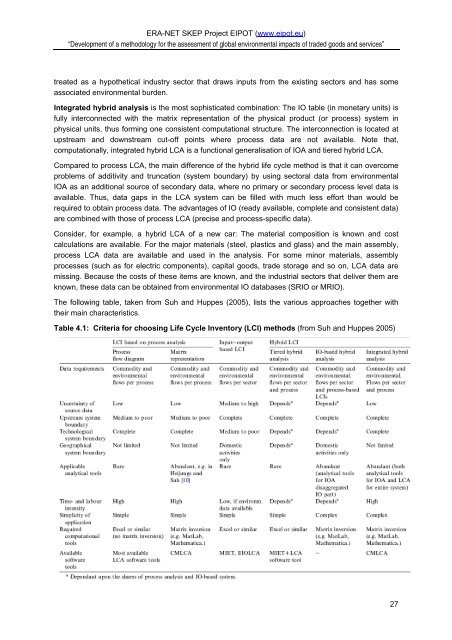EIPOT Final Project Report - Stockholm Environment Institute
EIPOT Final Project Report - Stockholm Environment Institute
EIPOT Final Project Report - Stockholm Environment Institute
You also want an ePaper? Increase the reach of your titles
YUMPU automatically turns print PDFs into web optimized ePapers that Google loves.
ERA-NET SKEP <strong>Project</strong> <strong>EIPOT</strong> (www.eipot.eu)<br />
“Development of a methodology for the assessment of global environmental impacts of traded goods and services”<br />
treated as a hypothetical industry sector that draws inputs from the existing sectors and has some<br />
associated environmental burden.<br />
Integrated hybrid analysis is the most sophisticated combination: The IO table (in monetary units) is<br />
fully interconnected with the matrix representation of the physical product (or process) system in<br />
physical units, thus forming one consistent computational structure. The interconnection is located at<br />
upstream and downstream cut-off points where process data are not available. Note that,<br />
computationally, integrated hybrid LCA is a functional generalisation of IOA and tiered hybrid LCA.<br />
Compared to process LCA, the main difference of the hybrid life cycle method is that it can overcome<br />
problems of additivity and truncation (system boundary) by using sectoral data from environmental<br />
IOA as an additional source of secondary data, where no primary or secondary process level data is<br />
available. Thus, data gaps in the LCA system can be filled with much less effort than would be<br />
required to obtain process data. The advantages of IO (ready available, complete and consistent data)<br />
are combined with those of process LCA (precise and process-specific data).<br />
Consider, for example, a hybrid LCA of a new car: The material composition is known and cost<br />
calculations are available. For the major materials (steel, plastics and glass) and the main assembly,<br />
process LCA data are available and used in the analysis. For some minor materials, assembly<br />
processes (such as for electric components), capital goods, trade storage and so on, LCA data are<br />
missing. Because the costs of these items are known, and the industrial sectors that deliver them are<br />
known, these data can be obtained from environmental IO databases (SRIO or MRIO).<br />
The following table, taken from Suh and Huppes (2005), lists the various approaches together with<br />
their main characteristics.<br />
Table 4.1: Criteria for choosing Life Cycle Inventory (LCI) methods (from Suh and Huppes 2005)<br />
27
















